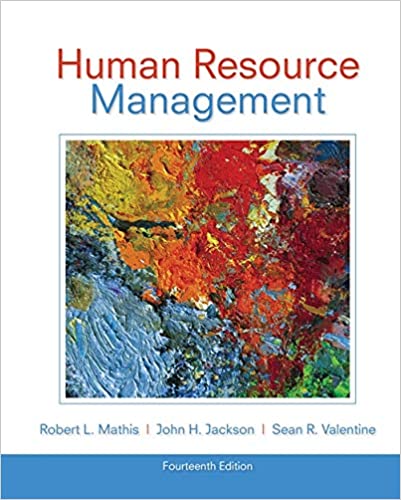
Human Resource Management 14th Edition by Robert Mathis,Sean Valentine,John Jackson
Edition 14ISBN: 978-1133953104
Human Resource Management 14th Edition by Robert Mathis,Sean Valentine,John Jackson
Edition 14ISBN: 978-1133953104 Exercise 3
Reducing Turnover at Rosemont Center
Rosemont Center Inc., in Columbus, Ohio, is a mental health and social services agency providing services to youths and low-income families. The services provided include outpatient therapy, foster care, day treatment, and mental health services.
Annual employee turnover reached 72%. The 62 employees included therapists, counselors, and social workers. At its peak the staff numbered 150 but funding cuts led to elimination of some programs. During the ensuing layoffs, voluntary turnover jumped. Low morale and motivation became a problem for the survivors, and the quality of services was affected.
The HR Director checked the accuracy of the turnover metrics to verify their validity and then put together a task force to identify causes. They identified the following causes:
• Demanding work
• Work-life balance-night work and weekends
• Low salaries
• On-call responsibilities without compensation
Exit interviews and employee satisfaction surveys were reviewed, and managers of similar agencies in Ohio were interviewed. These interviews were performed to hopefully find solutions that could improve employee satisfaction and reduce turnover.
Recommendations to the board for change from the task force included:
• Career development -internal job bidding for promotions and transfers to allow employees to apply for positions at Rosemont even before they were vacant and make an internal list of people who would consider jobs at the center.
• Rewards -a salary study to make sure salaries were competitive.
• Management and organization -develop a system of support for directors and supervisors to reduce recruiting costs and orientation costs for new employees. Encourage openness in communication so employees felt free to make suggestions or express concerns.
• Work-life balance -promote employee assistance programs and provide training on work-life balance.
With backing from the board of directors, the resulting program reduced turnover to 48%. The job bidding was a key element in that success. Compensation was increased as a result of the salary study, and employees were given more choices of benefits. Rosemont generated a list of candidates who wanted to work there. When a position opened, there were several candidates from which to choose. Formal training for management personnel had a positive effect on staff, who began to feel more supported by their supervisors. The company developed a training agenda which received funding. Finally, quarterly all-staff meetings and other events began fostering a more open culture.
The improved turnover rate with attendant reduced costs and better morale impressed the board members, and resulted in improved service as well. 61
QUESTIONS
1. Did the social services nature of this organization make the turnover situation any different that in a private company? Why or why not?
2. Have you seen similar efforts occur in places where you have worked? Describe them and comment on their success in that context. What could have been done differently?
Rosemont Center Inc., in Columbus, Ohio, is a mental health and social services agency providing services to youths and low-income families. The services provided include outpatient therapy, foster care, day treatment, and mental health services.
Annual employee turnover reached 72%. The 62 employees included therapists, counselors, and social workers. At its peak the staff numbered 150 but funding cuts led to elimination of some programs. During the ensuing layoffs, voluntary turnover jumped. Low morale and motivation became a problem for the survivors, and the quality of services was affected.
The HR Director checked the accuracy of the turnover metrics to verify their validity and then put together a task force to identify causes. They identified the following causes:
• Demanding work
• Work-life balance-night work and weekends
• Low salaries
• On-call responsibilities without compensation
Exit interviews and employee satisfaction surveys were reviewed, and managers of similar agencies in Ohio were interviewed. These interviews were performed to hopefully find solutions that could improve employee satisfaction and reduce turnover.
Recommendations to the board for change from the task force included:
• Career development -internal job bidding for promotions and transfers to allow employees to apply for positions at Rosemont even before they were vacant and make an internal list of people who would consider jobs at the center.
• Rewards -a salary study to make sure salaries were competitive.
• Management and organization -develop a system of support for directors and supervisors to reduce recruiting costs and orientation costs for new employees. Encourage openness in communication so employees felt free to make suggestions or express concerns.
• Work-life balance -promote employee assistance programs and provide training on work-life balance.
With backing from the board of directors, the resulting program reduced turnover to 48%. The job bidding was a key element in that success. Compensation was increased as a result of the salary study, and employees were given more choices of benefits. Rosemont generated a list of candidates who wanted to work there. When a position opened, there were several candidates from which to choose. Formal training for management personnel had a positive effect on staff, who began to feel more supported by their supervisors. The company developed a training agenda which received funding. Finally, quarterly all-staff meetings and other events began fostering a more open culture.
The improved turnover rate with attendant reduced costs and better morale impressed the board members, and resulted in improved service as well. 61
QUESTIONS
1. Did the social services nature of this organization make the turnover situation any different that in a private company? Why or why not?
2. Have you seen similar efforts occur in places where you have worked? Describe them and comment on their success in that context. What could have been done differently?
Explanation
Turn over refers to the employees leavin...
Human Resource Management 14th Edition by Robert Mathis,Sean Valentine,John Jackson
Why don’t you like this exercise?
Other Minimum 8 character and maximum 255 character
Character 255


